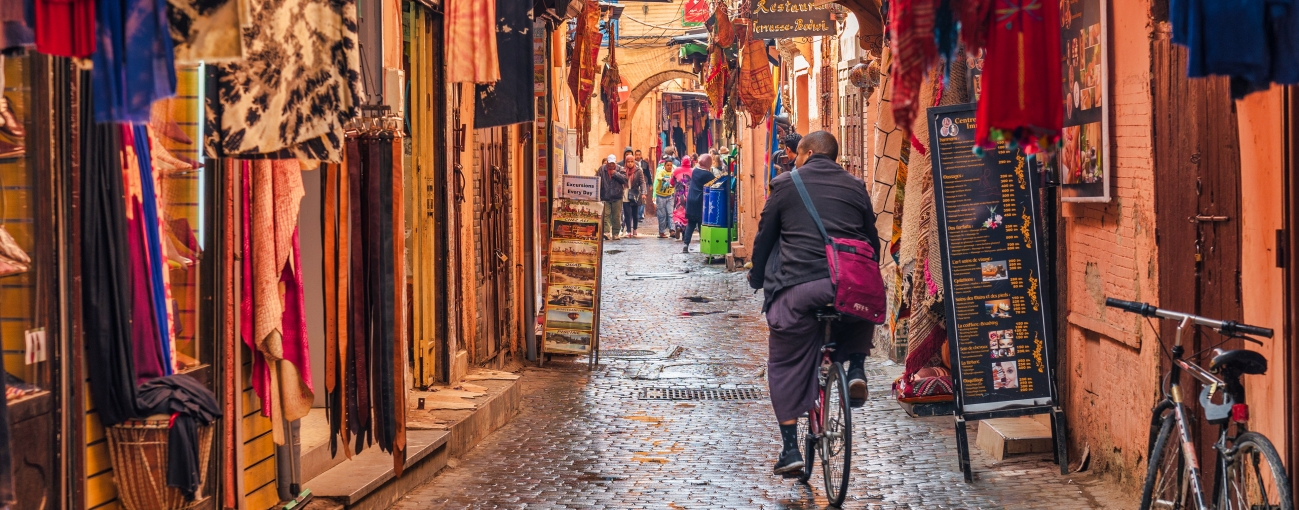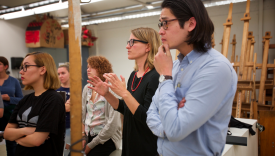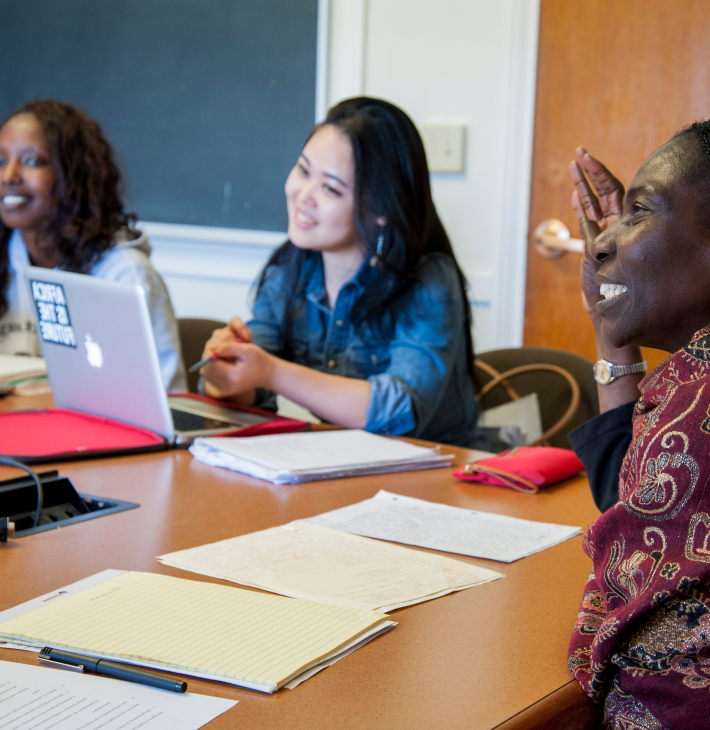
Languages
Conducting research, preparing for a career, gaining a better understanding of the world: there are many great reasons for wanting to learn a new language, or to continue your language studies.
Students at Five College campuses can study more than 60 languages; among the most offered anywhere in the country. Some of these languages are taught by our member campuses, some as Five College programs, and the majority--more than 40--are offered through the Five College Center for World Languages. On these pages you find out more about where these languages are offered, how they are taught, and how you can enroll.
Afrikaans is a West Germanic language related to Dutch that is spoken primarily in South Africa and Namibia, with about 9 million speakers. It is of particular relevance to anyone interested in the history of Apartheid.
Afrikaans is offered by the Five College Center for World Languages.
Albanian is an Indo-European language spoken by about 7.5 million people in Albania, Kosovo, and the Balkans. It also has co-official or minority status in North Macedonia, Croatia, Italy, Romania, and Serbia. There is an Albanian-speaking population of about 250,000 people in the United States.
Albanian is offered by the Five College Center for World Languages.
American Sign Language (ASL) is one of the fastest growing languages in U.S. higher education and is now the third most-commonly studied language behind French and Spanish.
Learn more about Five College ASL.
The origins of the Amharic language can be traced back to the 1st millennium B.C. Today it is spoken by more than 17 million people and is one of Ethiopia's major languages.
Amharic is offered by the Five College Center for World Languages.
Egyptian Arabic is the spoken Arabic dialect of Egypt. While primarily a spoken language, it is sometimes used in plays, poems, comics, and popular songs.
Egyptian Arabic is offered by the Five College Center for World Languages.
Levantine Arabic is the Arabic dialect primarily spoken along the Levantine Sea, an area that includes Lebanon, Jordan, Syria, Palestine, and Israel.
Levantine Arabic is offered by the Five College Center for World Languages.
Moroccan Arabic is the spoken Arabic dialect of Morocco. Over its history, Moroccan Arabic has incorporated influences from Latin, French, Spanish, and Persian.
Moroccan Arabic is offered by the Five College Center for World Languages.
Armenian is the official language of Armenia. It has two main variants, Eastern Armenian and Western Armenian. Written Armenian uses its own writing system, the Armenian alphabet, which dates back to the 5th century AD. The Armenian language is also widely used amongst the worldwide Armenian diaspora, with large populations in Russia, the United States, and France.
Armenian is offered by the Five College Center for World Languages.
Bengali/Bangla is spoken primarily in Bangladesh and the Indian States of West Bengal, Tripura, and the Barak Valley of Assam. There are also large Bengali-speaking communities in the United States, United Kingdom, Pakistan, and the Middle East. Bengali is the fifth most-spoken native language and seventh most spoken language in the world by total number of speakers.
Bengali is offered by the Five College Center for World Languages.
Bosnian, Croatian, and Serbian are mutually intelligible language varieties spoken by 21 million people across Bosnia and Herzegovina, Croatia, Serbia, and Montenegro.
Bosnian-Croatian-Serbian are offered by the Five College Center for World Languages.
Some 8-9 million people speak Bulgarian, the official language of Bulgaria and a minority language in many Eastern European countries. Bulgarian is the first Slavic language found recorded in writing.
Bulgarian is offered by the Five College Center for World Languages.
Burmese is the official language of Myanmar and is spoken by two thirds of the population, about 33 million people. The Burmese alphabet, a Brahmic script characterized by its circular letters, is used for standard Burmese as well as Pali, the liturgical language of Theravada Buddhism.
Burmese is offered by the Five College Center for World Languages.
Cantonese is the dominant language of Hong Kong and Macau, and the lingua franca of China’s Guangdong province. It is used in many popular TV shows, movies, and songs. It is widely spoken among members of the global Chinese diaspora.
Cantonese is offered by the Five College Center for World Languages.
Offered by: UMass
Czech is spoken by almost 11 million people. There is also a sizeable Czech diaspora in the United States, where about 70,000 people speak it as a first language.
Czech is offered by the Five College Center for World Languages.
Danish is spoken by about 6 million people, primarily in Denmark. It is also widely spoken and understood in Greenland and the Faroe Islands.
Danish is offered by the Five College Center for World Languages.
Dari, also known as Afghan Persian, is one of the two official languages of Afghanistan. Dari has a rich tradition of proverbs that are often used in daily conversation.
Dari is offered by the Five College Center for World Languages.
Over 24 million people speak Dutch. Dutch is the official language of the Netherlands and one of Belgium’s three official languages. It also holds official status in Suriname, Aruba, Curaçao, and Sint Maarten.
Dutch is offered by the Five College Center for World Languages.
Old English, Old Norse, Gothic, and other medieval languages are periodically offered as classroom courses or special studies at Smith College by Professor Craig Davis.
Filipino is a standardized variety of the Tagalog language, and the national language of the Philippines. It is the first language of about one third of the population, while many more people speak it as a second language.
Filipino is offered by the Five College Center for World Languages.
Finnish is spoken mainly in Finland, with small populations of speakers in Norway and Sweden. Finnish is a member of the Uralic language family, which includes Hungarian, Estonian, and Sami.
Finnish is offered by the Five College Center for World Languages.
Georgian, the official language of Georgia, is a Kartvelian language spoken by almost 4 million people. Historical examples of its unique script date back to the 5th century AD.
Georgian is offered by the Five College Center for World Languages.
Modern Greek is spoken by 13 million people in Greece, Cyprus, and Albania. There are also about 300,000 Greek speakers in the United States, which has the largest population of people of Greek descent outside of Greece.
Greek is offered by the Five College Center for World Languages.
Haitian Creole is the world's most spoken creole language with about 12 million speakers worldwide. It is also widely spoken by Haitian communities in Cuba, the Bahamas, and the Dominican Republic. In the United States, there are large communities of Haitian Creole speakers in Miami, Orlando, New York, and Boston.
Haitian Creole is offered by the Five College Center for World Languages.
Hindi has been influenced by Sanskrit as well as by the hundreds of regional languages of the Indian subcontinent. Taken together, Hindi and Urdu are some of the most widely spoken languages in the world, with about 544 million total speakers.
Hindi is offered by the Five College Center for World Languages.
Hungarian, at 13 million speakers, is the most widely spoken of the Uralic language family. It is the official language of Hungary, and the language of Hungarian communities in Slovakia, Ukraine, Romania, Serbia, Croatia, and Slovenia.
Hungarian is offered by the Five College Center for World Languages.
Igbo is a language of the Niger-Congo family. Originating in the Igboland or southwestern region of Nigeria, today it is spoken by some 20-25 million people worldwide.
Igbo is offered by the Five College Center for World Languages.
Indonesian is the standardized version of Malay used in Indonesia. Indonesian is one of the most spoken languages in the world, with almost 200 million speakers who use it as a first or second language.
Indonesian is offered by the Five College Center for World Languages.
Though English is the most common first language in Ireland, Irish is recognized as the national language and is still spoken by significant populations in the counties of Galway, Kerry, Cork, and Donegal. It is taught as a core subject in all public schools and in 4,000 Irish-language schools, or Gaelscoileanna, across Ireland and Northern Ireland.
Irish is offered by the Five College Center for World Languages.
Offered by:
See also the Five College East Asian Languages Program.
Kazakh is a Turkic language with about 12 million native speakers in the Kazakh Republic. Large groups of Kazakh speakers are also present in China, Mongolia, Uzbekistan, Turkey, Russia, and Afghanistan.
Yoruba is offered by the Five College Center for World Languages.
Offered by:
See also the Five College Korean Program and the Five College East Asian Languages Program.
Lao is primarily spoken in Laos, where it serves as an important Lingua Franca among a population that speaks about 90 other languages. Spoken Lao is mutually intelligible with Thai even though it is written with a different script.
Lao is offered by the Five College Center for World Languages.
For over half a millennium, Malay has been a major lingua franca of the Indonesian archipelago. It is widely spoken by almost 300 million people in Brunei, Indonesia, Malaysia, Singapore, and parts of Thailand. Over time the vocabulary of Malay has expanded to include loanwords from Arabic, Sanskrit, Dutch, Chinese dialects, and English.
Malay is offered by the Five College Center for World Languages.
Mongolian has about 5 million speakers across Mongolia and the Inner Mongolia Autonomous Region of China. It is commonly written in two scripts, Cyrillic and the traditional Mongolian script.
Mongolian is offered by the Five College Center for World Languages.
Nepali is the official language of Nepal and has a significant number of speakers in India and Bhutan. It is the most widely spoken of the Pahari languages of the Himalayas and Northern India.
Nepali is offered by the Five College Center for World Languages.
Norwegian is a North Germanic language spoken by 5.3 million people, mostly in Norway. Norwegian is part of a dialect continuum that includes its Scandinavian neighbors, Danish and Swedish.
Norwegian is offered by the Five College Center for World Languages.
Persian is spoken by over 100 million people in Iran, Tajikistan, and Afghanistan. There is also a large population of Persian speakers in "Tehrangeles" in California. Persian for centuries was the lingua franca from Central Asia to India and Iran. It has strongly influenced Urdu and Turkic languages.
Persian is currently offered by the UMass Department of Judaic and Near Eastern Studies.
Quechua is periodically offered by the UMass Department of Spanish and Portuguese Studies, typically as a summer course.
Romanian is a Balkan Romance language native to Romania and Moldova. About 30 million people speak it as a first or second language.
Romanian is offered by the Five College Center for World Languages.
Sinhala is spoken by about 20 million people in Sri Lanka, where it is one of the two official languages. Historians believe Sinhala has been in use since as far back as 200 BC.
Sinhala is offered by the Five College Center for World Languages.
Swahili is the lingua franca of east and central Africa, widely used in Kenya, Tanzania, and Uganda and spoken by more than 50 million people. It belongs to the Bantu family of languages and has influenced and been influenced by a variety of other languages, including Arabic, Portuguese, and German.
Swahili is offered by the Five College Center for World Languages.
Swedish is the official language of Sweden and one of two official languages of Finland. It shares many similarities with Danish and Norwegian.
Swedish is offered by the Five College Center for World Languages.
Thai is the most spoken of the Tai languages of Southeast Asia. Over 40 million people speak Thai as a first or second language. Spoken Thai is similar to and mutually intelligible with Lao.
Thai is offered by the Five College Center for World Languages.
Over 6 million people across Tibet, India, and Nepal speak a dialect of Modern Tibetan. The Tibetan language is of particular interest to anyone studying Buddhism.
Tibetan is offered by the Five College Center for World Languages.
Turkish is the official language of Turkey and is also widely spoken in Bulgaria, Greece, North Macedonia, Albania, Northern Cyprus, and in the European Turkish diaspora. Turkish belongs to the Altay branch of the Ural-Altaic linguistic family. It is considered a critical language by the U.S. government.
Turkish is offered by the Five College Center for World Languages.
Twi is widely spoken in Ghana. It is part of the Kwa subdivision of the NigerCongo group of African languages. Twi is relevant for students of anthropology, linguistics, and folklore.
Twi is offered by the Five College Center for World Languages.
Ukrainian is spoken by about 35 million people in Ukraine. It is also spoken by over 1 million people in Russia, and 200,000 people in Canada.
Ukrainian is offered by the Five College Center for World Languages.
Urdu is the national language of Pakistan and has been influenced by Persian and Arabic. Taken together, Hindi and Urdu are some of the most widely spoken languages in the world, with about 544 million total speakers.
Urdu is offered by the Five College Center for World Languages.
Vietnamese, the official language of Vietnam, is spoken natively by about 76 million people. Significant Vietnamese-speaking communities also exist in North America, Australia, and Europe, particularly in the Czech Republic, where Vietnamese has been officially recognized as a minority language.
Vietnamese is offered by the Five College Center for World Languages.
Wolof is the most widely spoken of Senegal's six national languages, and is an important language for local trade and arts. It is also spoken in the Gambia and Mauritania.
Wolof is offered by the Five College Center for World Languages.
Yoruba is spoken by more than 30 million people in West Africa in Nigeria, Togo, Benin, and Sierra Leone.
Yoruba is offered by the Five College Center for World Languages.



